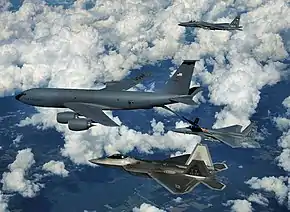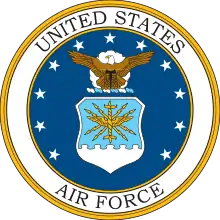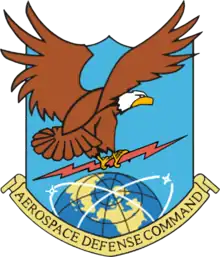325th Fighter Wing
The 325th Fighter Wing (325 FW) is a wing of the United States Air Force based in Tyndall Air Force Base, Florida.
| 325th Fighter Wing | |
|---|---|
 An F-22 Raptor and two F-15 Eagles from Tyndall Air Force Base refuel from a KC-135 Stratotanker of the Mississippi Air National Guard over eastern Florida, 22 September 2008. | |
| Active | 1948–1952; 1956–1968; 1981–present |
| Country | |
| Branch | United States Air Force |
| Part of | Air Combat Command |
| Garrison/HQ | Tyndall Air Force Base |
| Motto(s) | Locare et Liquidare Latin Locate and Liquidate |
| Decorations | Distinguished Unit Citation Air Force Outstanding Unit Award |
| Commanders | |
| Current commander | Colonel Gregory M. Moseley[1] |
| Notable commanders | Richard Myers |
| Insignia | |
| 325th Fighter Wing emblem (approved 5 March 1957)[2] |  |
Mission
The 325th Fighter Wing's primary mission is to provide air dominance training for F-22 Raptor pilots and maintenance personnel and air battle managers to support the combat Air Force.
Training for F-22 pilots is performed in the 43d Fighter Squadron. The 325th Air Control Squadron trains air battle managers for assignment to combat Air Force units. Additionally, wing personnel manage the southeastern air combat maneuvering instrumentation range and provide mission-ready F-22 air dominance forces in support of the Commander, North American Aerospace Defense Command (NORAD)/1st Air Force (1 AF) contingency plans. The 325th Fighter Wing is commanded by Colonel Gregory M. Moseley, who assumed command 26 June 2020.
Other specialties trained under the 325th Fighter Wing include F-22 intelligence officer training, F-22 crew chief training and officer and enlisted air traffic controller training.
The 325th Fighter Wing is host to more than 30 tenant organizations located at Tyndall Air Force Base, Fla. The wing comprises the 325th Operations Group, 325th Maintenance Group, 325th Mission Support Group and 325th Medical Group.
From 1983 to 2010, training for F-15 pilots was performed at Tyndall by the 1st, 2d, and 95th Fighter Squadrons. During this period, the 325th FW also hosted training for F-15 Maintenance personnel, and Intelligence Officers assigned to F-15 units. The 1st Fighter Squadron was inactivated in 2006. The 2d and 95th FS's were also inactivated in May and September 2010, respectively. However, with the return to Air Combat Command, the 325th FW gained a combat-coded F-22 squadron.[3] In doing so, the 95th Fighter Squadron was reactivated on 11 October 2013 as an operational F-22 Raptor unit. In August 2014, the 2d was reactivated as the 2d Fighter Training Squadron. Flying the Northrop T-38 Talon, the 2d provides adversary training support to F-22 squadrons.
Units
|
325th Operations Group (325 OG)
325th Maintenance Group (325 MXG)
|
325th Mission Support Group (325 MSG)
325th Medical Group (325 MDG)
|
History

The 325th Fighter Wing was established on 10 May 1948 and activated on 9 June 1948. It conducted air defense of the U.S. west coast, 1948–1952 and 1956–1968. Beginning in spring 1949, the 325th conducted the All Weather Combat Crew Training School. During 1950, the wing also controlled a troop carrier squadron and from May 1950 to June 1951, provided training for elements of a troop carrier wing. On 6 February 1952 the Wing was inactivated and replaced by the 4704th Air Defense Wing, which assumed most of its operational role, while the 567th Air Base Group assumed its host base functions.
An Air Defense Command program to reactivate historic units named "Project Arrow" resulted in the reactivation of the 325th Fighter Group (Air Defense) on 18 August 1955. The 325th group assumed the mission, personnel and equipment of the 567th Air Defense Group. The 325th served as the "host" unit at McChord Air Force Base until October 1956. From February to July 1968, the wing operated an air defense detachment at Osan Air Base, South Korea. The 325th was again inactivated in late 1968. The 325th Fighter Wing was activated on 18 October 1956 and was assigned the 325th group as a subordinate unit controlling its operational squadrons.
On 22 October 1962, before President John F. Kennedy told Americans that missiles were in place in Cuba, the wing dispersed a portion of its force, equipped with nuclear tipped missiles to Paine Air Force Base at the start of the Cuban Missile Crisis.[5] These planes returned to McChord after the crisis.
On 15 March 1963 two Soviet bombers overflew Alaska and Alaskan Air Command F-102s were unable to intercept them.[6] The response to this intrusion was to deploy ten F-106s from the wing to Alaska in what was called Operation White Shoes.[7] However, maintaining these aircraft for an extended period of time put a strain on the wing's combat readiness back at McChord, and eventually a detachment of maintenance personnel was established to maintain the planes in Alaska. The wing got relief from this commitment while it was upgrading its F-106s from the 1st Fighter Wing, which relieved it from March to June 1964. Operation White Shoes terminated in 1965 and the unit's planes returned home.[8]
The wing was reactivated at Tyndall Air Force Base in 1981. It provided Air Defense Weapons Center operational and technical advice on air defense and tactics from, 1981–1983. It also provided test and evaluation new air defense equipment, including use of the PQM-102 and QF-100, former operational aircraft modified to function as unmanned drones. In October 1983, the wing assumed a new mission of conducting qualification training of tactical aircrews. Beginning in 1983 it deployed T-33 and later, F-15 aircraft to USAF, Air National Guard, Marine Corps, and Navy air units to provide electronic countermeasures and dissimilar air combat training and to increase aircrew combat proficiency. The wing performed alert duties from, 1988–1990, intercepting unidentified aircraft and assisting the U.S. Drug Enforcement Administration in anti-smuggling efforts. It became host unit at Tyndall Air Force Base in September 1991.
F-22 Raptor
The 325th has conducted the Air Force's basic course and transition training for the F-22 since 2003. In October 2012, the wing was reassigned from Air Education and Training Command to Air Combat Command, since it had added a combat coded squadron to its training units.[3] This unit, the 95th Fighter Squadron, and other elements of the wing completed their first six-month long combat deployment with the Raptor in May 2015.[9]
Lineage
- Established as the 325th Fighter Wing, All Weather on 10 May 1948
- Activated on 9 June 1948
- Redesignated 325th Fighter-All Weather Wing on 20 January 1950
- Redesignated 325th Fighter-Interceptor Wing on 1 May 1951
- Inactivated on 6 February 1952
- Redesignated 325th Fighter Wing (Air Defense) on 14 September 1956
- Activated on 18 October 1956
- Discontinued and inactivated on 1 July 1968
- Redesignated 325th Fighter Weapons Wing on 17 June 1981
- Activated on 1 July 1981
- Redesignated 325th Tactical Training Wing on 15 October 1983
- Redesignated 325th Fighter Wing on 1 October 1991
Assignments
- Fourth Air Force, 9 June 1948
- Attached to Western Air Defense Force, 10 November 1949 – 31 July 1950
- Western Air Defense Force, 1 August 1950 – 6 February 1952
- 25th Air Division, 18 October 1956
- Seattle Air Defense Sector, 10 February 1960
- 25th Air Division, 1 April 1966 – 1 July 1968
- USAF Air Defense Weapons Center, 1 July 1981
- First Air Force, 12 September 1991
- Nineteenth Air Force, 1 July 1993
- Ninth Air Force, 1 October 2012 – Present
Components
Wings
- 302d Troop Carrier: attached 6 May 1950 – 8 June 1951
Groups
- 325th Fighter (later, 325th Fighter-Interceptor; 325th Fighter; 325th Operations): 9 June 1948 – 6 February 1952; 18 October 1956 – 25 March 1960; 1 September 1991–present
Squadrons
- 1st Tactical Fighter Training: 1 January 1984 – 15 December 2006
- 2d Fighter-Interceptor Training (later, 2d Fighter Weapons; 2d Tactical Fighter Training): 1 July 1981 – 11 May 2010
- 4th Troop Carrier: attached 1 May – 17 July 1950
- 82d Tactical Aerial Target (later, 82d Tactical Aerial Targets): 1 July 1981 – 15 October 1983
- 95th Fighter Interceptor Training (later, 95th Tactical Fighter Training): 1 July 1981 – present
- 123d Fighter: attached 10–12 February 1951
- 317th Fighter Interceptor Squadron: attached 18 October 1956-c. June 1957
- 318th Fighter Interceptor Squadron: attached 18 October 1956-c. June 1957; assigned 25 March 1960 – 1 July 1968
- 325th Air Control Squadron: 15 October 1983 – 3 October 2012 (redesignated 337th ACS on 3 October 2012 and remains at Tyndall as an associate unit of the 33d Fighter Wing at Eglin Air Force Base)
- 460th Fighter-Interceptor Training Squadron: 15 January – 15 October 1982
- 475th Test Squadron: 1 July 1981 – 15 October 1983
- 498th Fighter-Interceptor Squadron: attached 18 October 1956-c. June 1957; 1 July 1963 – 25 June 1966
- 4756th Air Defense: 1 July 1981 – 15 October 1983
School
- USAF Interceptor Weapons: 1 July 1981 – 15 October 1983.
Stations
- Hamilton Air Force Base, California, 9 June 1948
- Moses Lake Air Force Base, Washington, 23 November 1948
- McChord Air Force Base, Washington, 20 April 1950 – 6 February 1952
- McChord Air Force Base, Washington, 18 October 1956 – 1 July 1968
- Tyndall Air Force Base, Florida, 1 July 1981–present
Aircraft assigned
|
|
References
![]() This article incorporates public domain material from the Air Force Historical Research Agency website http://www.afhra.af.mil/.
This article incorporates public domain material from the Air Force Historical Research Agency website http://www.afhra.af.mil/.
Notes
- "Colonel Gregory M. Moseley".
- Ravenstein, pp. 176–177
- Elsea, SSG Rachelle (4 October 2012). "325th FW reassigned to ACC in ceremony". 325th Fighter Wing Public Affairs. Archived from the original on 24 February 2013. Retrieved 1 November 2012.
- Aircraft are North American QF-100 Super Sabre target drones on 25 April 1990. The first five aircraft are single-seat QF-100Ds (serials 55-3784, 56-3365, 56-3112, 55-3741, and 56-3093) and a two-seat QF-100F (serial 56-3865)
- McMullen, pp. 10–12
- McMullen, p. 27
- McMullen, pp. 28–29
- McMullen, pp. 32–34
- Echols, SRA Alec (14 May 2015). "Tyndall completes first combat deployment". Air Combat Command Public Affairs. Retrieved 18 May 2015.
Bibliography
- McMullen, Richard F. (1964) "The Fighter Interceptor Force 1962–1964" ADC Historical Study No. 27, Air Defense Command, Ent Air Force Base, CO (Confidential, declassified 22 March 2000)
- Ravenstein, Charles A. (1984). Air Force Combat Wings, Lineage & Honors Histories 1947–1977. Washington, DC: Office of Air Force History. ISBN 0-912799-12-9.


